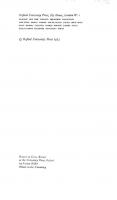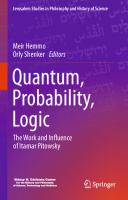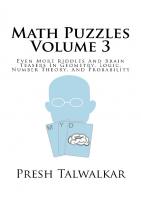Studies in Inductive Logic and Probability: Volume 2 [Reprint 2020 ed.] 9780520318328
158 22 22MB
English Pages 312 Year 2020
Recommend Papers
![Studies in Inductive Logic and Probability: Volume 2 [Reprint 2020 ed.]
9780520318328](https://ebin.pub/img/200x200/studies-in-inductive-logic-and-probability-volume-2-reprint-2020nbsped-9780520318328.jpg)
- Author / Uploaded
- Richard C. Jeffrey (editor)
File loading please wait...
Citation preview
Studies in Inductive Logic and Probability V O L U M E II
Studies In Inductive Logic and Probability V O L U M E II
Richard C. Jeffrey, Editor
UNIVERSITY
OF C A L I F O R N I A
PRESS
B E R K E L E Y . LOS A N G E L E S . L O N D O N
University of California Press Berkeley and Los Angeles, California University of California Press, Ltd. London, England Copyright © 1980 by The Regents of the University of California ISBN: 0-520-03826-6 Library of Congress Catalog Card Number: 77-136025 Printed in the United States of America Designed by Dave Comstock
Contents Introduction
1
6 A Basic System of Inductive Logic, Part 2 by Rudolf Carnap 7 14. The Attribute Space; Distances and Widths 7 15. Basic and Admissible Regions in the Attribute Space 20 16. The Analogy Influence 32 17. The Eta Function 50 18. Some Special Kinds of Families 72 19. Lambda-Families 84 20. The Limit Axioms 120 21. The Problem of a more General Concept of Regularity 145 7. An Axiomatic Foundation lor the Logic of Inductive Generalization by Jaakko Hintikka and Ilkka Niiniluoto 157 8. A Survey of Inductive Systems by Theo A. F. Kuipers 183 9. On the Condition of Partial Exchangeability by Bruno de Finetti 193 10. Representation Theorems of the de Finetti Type by Godehard Link 207 11. De Finetti's Generalizations of Exchangeability by Persi Diaconis and David Freedman 233 12. The Structure of Probabilities Defined on First-Order Languages by Jens Erik Fenstad 251 13. A Subjectivisms Guide to Objective Chance by David Lewis 263 14. A Note on Regularity 295 Index to Volumes I and II by Aron Edidin and Paul Boghossian 297
Introduction Much delayed, here is the second, final volume of Studies in Inductive Logic and Probability. Carnap projected the series ca. 1959 as a nonperiodical journal for quick publication of advanced work in inductive logic. A medium for cooperative research, it would replace the abandoned second volume of the work ("Probability and Induction") of which his Logical Foundations of Probability (1950) was to have been Volume I, and in which The Continuum of Inductive Methods (1952) was to have been part of Volume II. First on Carnap's new agenda was composition of an account, for publication in 1960 or 1961, of how the project then stood. A first draft ("An Axiom System of Inductive Logic") was circulated privately for criticism, section by section as written. Upon finishing that he began a massive revision ("A Basic System of Inductive Logic") that received the same treatment. His deteriorating physical condition, and the death of his wife, delayed matters far beyond his early, unrealistic estimate of 1961 as a publication date. Ten years after beginning, he decided to publish Volume I with only the then complete first half of "A Basic System": Article 2. While seeing Volume I through the press he would revise the rest for publication soon thereafter in Volume II. But he died in 1970, with Volume I still in press and with his "Basic System" still incomplete. Thus Volume I was a decade late, and the foundations were laid for a similar delay in the appearance of Volume II. For the magnitude of that second delay I must apologize, especially to those who contributed earliest to this volume: Jens Erik Fenstad and Godehard Link. The articles here are numbered successively with the five of Volume I, and an index to both volumes is provided at the end of this one.
2
STUDIES IN INDUCTIVE LOGIC AND P R O B A B I L I T Y
Article 6 completes article 2 of the first volume: " A Basic System of Inductive Logic". Carnap revised §§14-18 for this volume, but died while he was revising §19. As he had done only the first few pages of that, and it was unclear just how he would have proceeded, I have kept to the first draft of §19, except for inevitable changes, for example, in the numbering of backward references. Carnap would surely have shortened §19, but I do not know how, and so have left it much as he did. The case is similar for §20, but there I have done a bit more serious editing, mainly at the beginning. In an obvious sense, " A Basic System of Inductive Logic" is Carnap's last word on the subject. But it got that status by accident. Carnap meant it to be a new first word: no grand overview but merely a revision of the ABCs. The last section, §21, was §8 of Carnap's first draft, "An Axiom System of Inductive Logic". He dropped that section in order to expedite publication of Volume I, but had meant to revise it for publication later. I have included it here in order to convey an idea of some of the directions that Carnap envisioned, some twenty years ago, for more advanced inquiries. The basic system concerns a single family of predicates P ( (/ = 1 , . . . ,k), precisely one of which applies to each individual at. The function is assumed to be symmetrical with respect to permutations of the at (i.e., the at are assumed to be exchangeable), so that all values are determined by the so-called singular predictive inference, i.e., the values q(su
...,sk)
= nPjas+11
P^a, •...•
PKas)
where s = s t + . . . + sk and where for j = 1 , . . . , k, s, is the number of occurrences of the number j in the sequence (hlt..., hs). Thus the conjunction in the second argument-place of above identifies a particular s, of the first s individuals as having the property P,. The members P, of the family may have distinct logical widths y, (nonnegative reals that sum to 1). In the A — y systems of Carnap's §19, C, is determined as T19-5f: C,(si, •
• • Sic)= . S i A
One can think of these ^-functions as modifications of the straight rule (the rule according to which C, is simply the relative frequency of P, in the first s individuals) in which we augment the s real individuals with A virtual individuals, among which Ay, have the
INTRODUCTION
3
property P, for each j = 1 , . . . , k. Then the value of Q C s , , . . . , s k ) given above is simply the relative frequency of P, among the s + A real and virtual individuals. Mathematically, these A - 7 systems are indistinguishable from Polya urn models with double replacement: initially the urn contains A balls, of which are of type j for each j = 1 , . . . , k; after the ith ball is drawn, it is returned to the urn together with one more ball of its type. Then after the ith drawing and double replacement, the proportion of balls in the urn of type Pj will be as specified by C ^ S j , . . . , sk) above. The crucial aspect of the A — y systems is that in them, C, is a function of its jth argument s, and of the sum s of all k arguments, but is independent of how the s — s, items in the sample that are not of type Pj are assorted among the other fc - 1 types. As Carnap points out in §§16 and 17 of article 6, there are cases where it seems unreasonable to overlook the similarity of observed individuals that are not of type P,. Example: roulette, with segments numbered 1 to 100 consecutively, and segment number j making an angle of 2-777, with the center of the wheel. With s = 60 and S! = 0, one might reasonably give higher credence to P i a 6 1 in case the 60 observed trials are scattered among the Pj in a disorderly manner than if all were of one type (say type P 51 , so that s 5 1 = s = 60). Carnap considers such analogy by similarity at length (e.g., in connection with the parameters 17), but considers analogy by proximity very briefly (at the end of §17), as consideration of "proximity influence" requires dropping the assumption of exchangeability of the individuals at. Thus, in the roulette example, analogy by proximity would lend greater credence to P, m. Thus 3> m = {X™, Xp,..., X £ J . Each region Xp represents an attribute Pp. In a qualitative family this is a qualitative attribute, in a quantitative family it is a quantitative attribute. In the example (2-3) for a partition of the value space, P i is the property of having an age higher than 30 and not higher than 35 years. Thus we assimilate the quantitative families to the qualitative ones. And also inversely, for a quantative family F " we introduce a real-valued function G m with attribute indices as values: (14-10)
(Gm (ai ) =
j)=oi Pp(ai ).
Any individual can now be characterized by one attribute in each family, thus by an n-tuple of attributes, say (P*, Pf2 ,..., P,"). These n-tuples are obviously the elements of the Cartesian product F 1 x F 2 + . . . x F". To each n-tuple (P^, P 2 , . . . , P,"), or simply to the n-tuple of indices ( j u j2,..., /„), there is a corresponding attribute QJli2. We call these attributes Q-attributes. We define: D14-16.
For any a„ Qhh ... J a, ) ^ pJ1i(ai)npf2(ai)n...npJ':(ai).
Thus a Q-attribute characterizes an individual completely within the frame-work of the n families. (The Q-predicates were first defined in [1950, §31], but only for families with fc = 2; the general case is briefly indicated in [1950, §18C].) n
(14-11)
The number of Q-attributes is k = f ] fcmm=1
In each space U m , there is a partition 2 x . . . x2>n of the product space U = U 1 x U 2 x . . . x U n . Each part, e.g., (X/,, X 2 , . . . , X"), represents one of the k Q-attributes, viz. Qjlj2...,n. We call the partition 3) the product partition or Qpartition. It seems natural to define a width function w for the product space U in the following way. (14-12)
w(*i,.J=ri m = l
[The present concept of width is a generalization of my earlier concept of "relative logical width" (1950, §32), which was based on a special form of Q-partition.]
15 Basic Regions and Admissible Regions in the Attribute Space A.
BASIC REGIONS
We go back to our language with one family F of k attributes: F = {P1, P2,.. •, Pk}. We shall consider the question as to which properties of these attributes are relevant for IL or, more specifically, for the determination of values of the functions and M for any propositions involving attributes of F. These k attributes are represented by the regions of a partition of the attribute space U, say { X l 5 . . . , Xfc}. We shall now consider the question of which properties of the k attributes P, and the regions Xi (/= 1 , . . . , k) are relevant for IL. I cannot give a definitive answer to these questions. But I wish to state partial and tentative answers in the form of three conjectures, CI, C2, and C3. I have used them in recent years as, so to speak, working hypotheses for intuitive, pre-systematic speculations. I state them in spite of their uncertainty, because I have found them useful in searching for rules of IL. Perhaps others might be willing to use them for the time being, "until further notice", or to suggest modifications. C15-1. First Conjecture. Only those properties of P m (those relations between P m and Pn) are essential for IL, i.e., for the determination of values of









